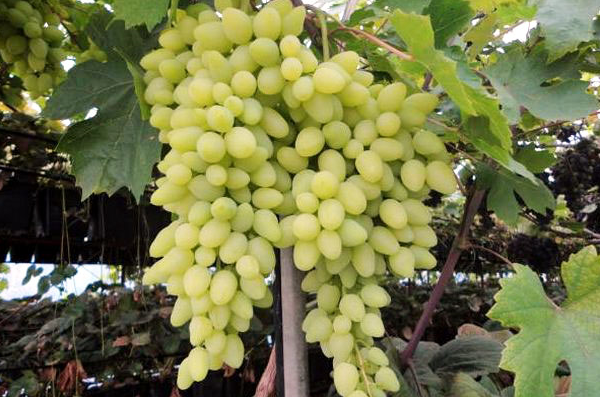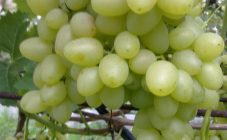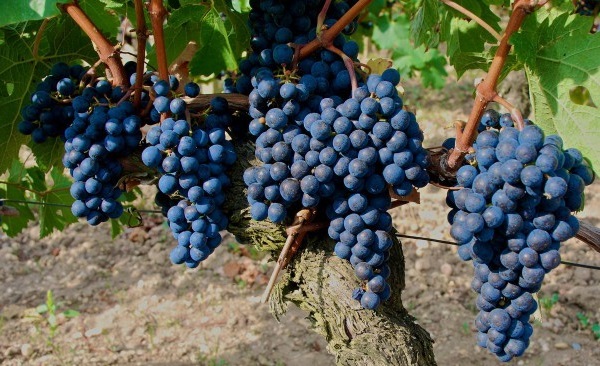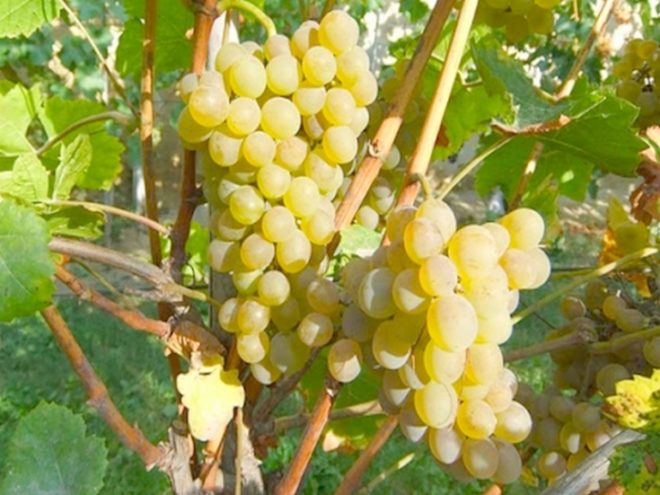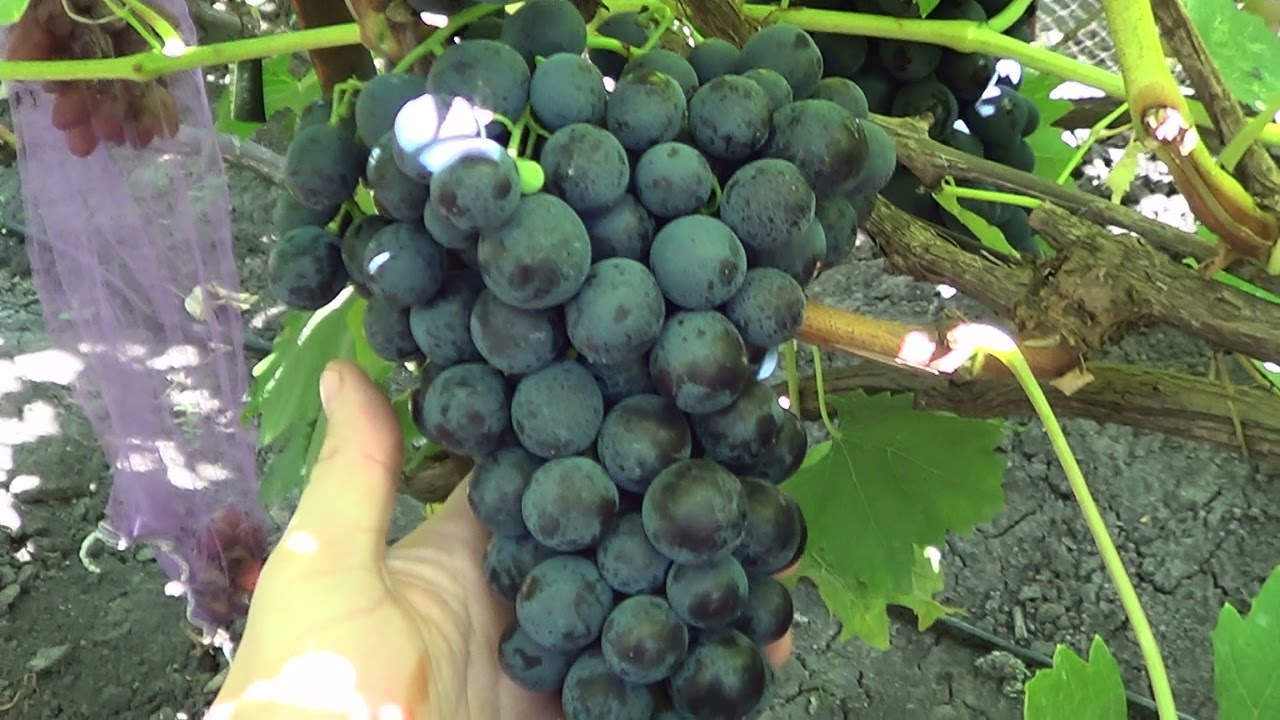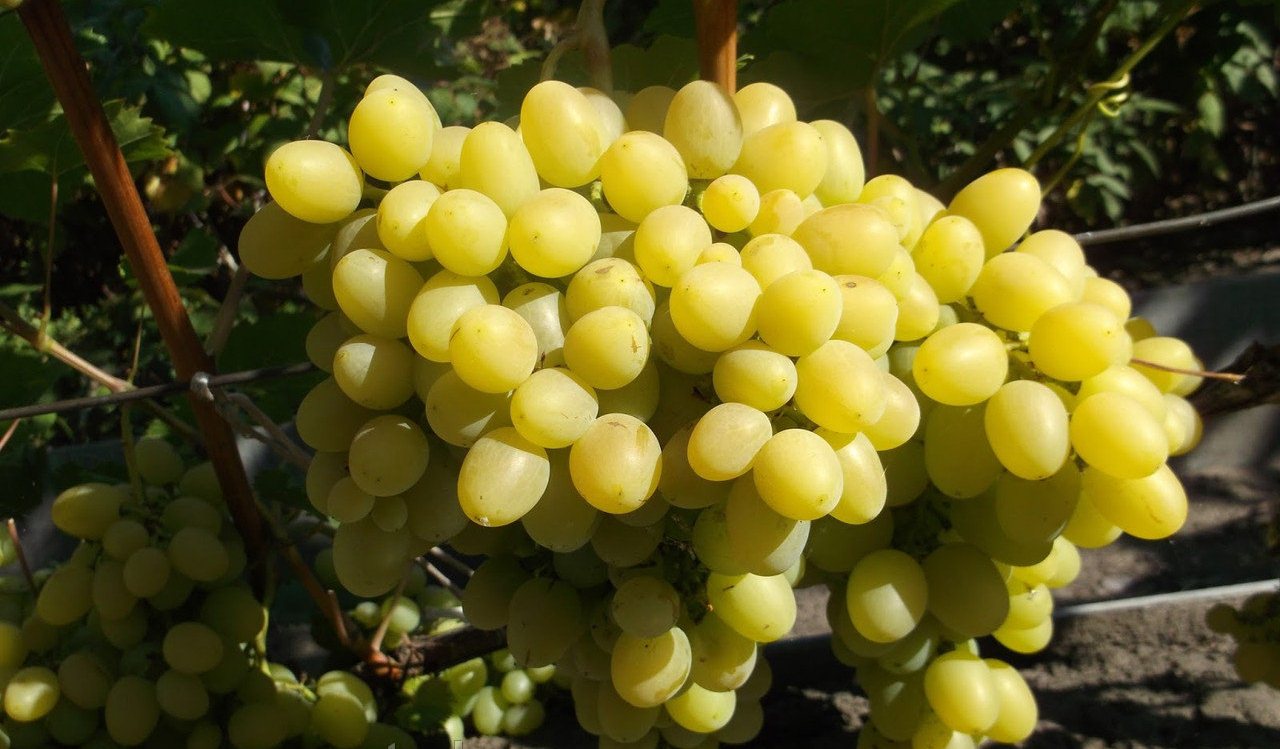Content:
Everyone knows what grape bunches with ripe berries look like, but not everyone has seen how grapes bloom. Even experienced gardeners do not always have an idea of how to improve the formation of ovaries and reduce the number of flowers shed by a plant.
Flowering grapes
The flowering period for grapes in different regions begins from the first days of May and lasts until the end of June. The flowers in the inflorescences open gradually one by one within 1-3 weeks. Bunches of grapes bloom for several hours a day. Most of the flowers bloom from 6.00 to 11.00. After the full opening of the bud, the stigmas remain susceptible to fertilization for 4 to 6 days. Fertilization lasts for one day, and then the stage of ovary formation begins.
You can expect a good harvest if the flowering vineyards are not flooded with rains and scorched by the sun. The most comfortable temperature for pollination and ovary formation is 25-30 ° C.
In regions with a cold climate, where the air temperature does not rise above 16 ° C, the flowering of the vineyards is sluggish. In such conditions, the flowers of a heat-loving plant do not open well, and their pollination is difficult. Cold climate negatively affects the formation of ovaries in inflorescences.
A large amount of pollen and flowers is formed on vines that receive adequate amounts of nutrients. Vineyards growing on impoverished soils do not bear fruit well.
Flowering stages and timing
After the first flowers in the brushes drop the corollas (caps), we can assume that the grapes have bloomed. First of all, brushes located close to the ground begin to bloom. Miniature flowers, collected in a bunch, bloom from the bottom of the cone-shaped inflorescence.
At the very beginning, the flowers bloom slowly, then the caps shed most of the buds, after which the flowering gradually ends. The timing of this period is very different depending on:
- grape varieties;
- growing region;
- weather conditions.
For the successful setting of berries in the brushes, it is necessary that there is a sufficient amount of nutrients in the soil. Vineyards that grow on depleted soil and are not fed with fertilizers are more active in shedding flowers and ovaries. As a result, shedding of flowers leads to the formation of clusters with a reduced density of berries and a decrease in yield.
They react negatively to lack of nutrition in the root layer of the soil:
- Albigllo,
- Ver dello,
- Isabel,
- Cabernet,
- Cleret,
- Malbec,
- Alexandrian Muscat,
- Riesling,
- Saperavi,
- Semillon,
- Senso,
- Black Crimean,
- Sabbat.
You can increase the yield of these varieties by introducing nutrition at the root 2 weeks before the start of active flowering. At the same time, you need to pinch the shoots.
The color may begin to crumble if, during flowering:
- it rains constantly;
- the air temperature dropped below 15 ° С;
- hot and dry winds blow.
Dry winds dry the adhesive liquid on the stigma, as a result of which the pollen cannot adhere to it and fertilize the flower. During rains, pollen washes off with water, and during a cold snap, pollination is difficult due to poor opening of flowers.
A hailstorm before flowering on grapes harms the future harvest much less than after the formation of ovaries in a plant.
How to reduce the amount of discolored flowers and ovaries
Fading, the grapes lose up to 60% of the color. This is a natural discharge and it is difficult to influence this process in any way. With a decrease in air temperature and after prolonged rains, the number of crumbling ovaries increases sharply.
When the grapes are in bloom, what should be done to ensure a good ovary rate? Prior to and during this period, the following care should be provided:
- timely prune the bush, preventing the formation of unnecessary shoots and foliage;
- during the formation of the crown between the fruit arrows, leave from 15 to 30 cm;
- reduce the amount of watering;
- loosen the ground near the stems;
- 10-14 days before the beginning of flowering, pinch the arrows.
The bushes need to be fed in the spring before flowering and after it ends in summer. For this purpose, solutions of trace elements designed to be sprayed onto grape leaves are well suited. For such foliar feeding, you can take:
- solution of brilliant green and iodine in milk;
- infusion of garlic and onion;
- boric acid solution;
- zeovite ovary plus.
Top dressing can be combined with preventive treatments of bushes against infectious diseases.
To carry out a number of preventive work, you need to at least roughly understand when flowering will come. How can you tell when grapes will bloom? It is very easy to calculate the flowering time. After inflorescences with buds have appeared on the vines, 20-25 days will pass before they begin to open.
Flowering time for different grape varieties
In different regions, grapes bloom at different times. In the south of the country, in the neighboring Krasnodar Territory and the Rostov Region, the flowering of crops occurs with a difference of 1-2 weeks. Vineyards growing in the Crimea and the coastal part of the Krasnodar Territory bloom in early - mid-May. In the Rostov region, in areas of developed viticulture near the Tsimlyansk reservoir, the flowering of this culture begins 2 weeks later. That is, for wine varieties, the flowering period, depending on weather conditions, may come in mid-late May, and in the Moscow region and the middle lane, the vineyard will begin to bloom not earlier than mid-June.
It should be understood that the plant can bloom at different times every year. The slight difference depends on the time the air temperature rises to the required level. If spring starts early, then the gardens begin to bloom earlier than usual.
Wine varieties are the first to bloom;
- Isabel,
- Pinot noir,
- Saperavi,
- Cabernet Sauvignon,
- Cabernet Franc,
- Merlot,
- Sangiovese,
- Syrah,
- Carmenere,
- Mourvedre,
- Grenache.
14 days after them bloom:
- Muromets,
- Laura,
- Original,
- Esther.
The structure of the grape flower and its pollination
The flowers of the grapes are small and grow on short twigs, collected in a bunch (panicle). Panicles quickly stretch out in length due to the growth of the central branch on which they are collected. Lateral branches are completely covered with flower buds. The main axis sets the size and shape of the future grape bunch.
How many days do grapes bloom? Development from bud to flower takes about 3 weeks. During this period, all flower organs are formed. The very same bloom of one flower lasts from 4 to 8 days, depending on the weather and plant variety.
At the very beginning, sepals are formed in the plant. Inside them, the rudiments of flower organs begin to appear: stamens and petals. Gradually, full-fledged ones develop from these tubercles:
- filaments,
- pestle,
- petals.
The pistil consists of a column, a stigma and an ovary.
Grapes bloom differently from other horticultural crops. The petals form a kind of cap (corolla) on the flower, which the plant sheds before pollination begins.
This culture has varieties that have:
- two types of flowers, distinguished by male and female type;
- only female flowers;
- flowers with sterile pollen (not fertile).
Some wild grapes have only male-type flowers. The varietal representatives of this culture do not have such deviations.
For normal cross-pollination, vineyards are organized as joint beds for several varieties. On one site you can combine wine and table grapes. Placing grape bushes in the vineyard, you need to take into account the timing of flowering. Otherwise, early flowering wine varieties will not be able to pollinate at the expense of table plants, which bloom 2 weeks later.
Pollination
Pollination of grapes occurs within 7-8 days. During this period, the flower becomes lighter in tone and moisturizes. You can find out about the readiness of a plant for pollination by a characteristic feature, which is the presence of an adhesive liquid on the flower stigma.
Most grape varieties are pollinated with pollen from neighboring plants. There are much fewer self-pollinated varieties that are able to use their own pollen for pollination.
It is believed that light and volatile grape pollen flies from one garden plant to the flowers of another representative of this species with gusts of wind, and only sometimes it is carried by bees. How is grapes really pollinated? Experienced growers dispute this opinion, citing as an argument in favor of insect pollination the fact that during flowering grape inflorescences smell of a pronounced honey aroma.
To increase yields, additional artificial pollination can be carried out. The yield will increase from 20 to 40%. Artificial pollination is carried out 2-3 times as new flowers open in the brushes. If the pollination period takes place on rainy days, additional pollination will have to be done manually.
Some varieties do not have their own pollen at all, these include:
- Elegant,
- Kesha-1,
- Atlant,
- Alina,
- Victoria
Vineyards with a girlish type of flowers need pollen from another plant for pollination. Bisexual grapes are planted next to such varieties.
To increase the yield, artificial manual pollination of grapes is carried out.
Even seedless grape varieties respond positively to pollination. In fact, like all other varieties, seeds begin to form inside the berries, but at the initial stage this process spontaneously collapses. Why this happens is not clear. Scientists consider this phenomenon a genetic malfunction that people have learned to use for their own good.
Bisexual grape species have adapted to the conditions of cross-pollination. For this, nature has provided them with a whole set of devices and tools:
- long-term maturation of pollen, stigma and ovaries, which, as a result, becomes an obstacle to pollination with its own biological material;
- staminate filaments sag in different directions from the pistil, such an arrangement of flower parts allows pollen to fall on neighboring flowers;
- selective attitude of grapes to the pollen of certain varieties.
There are varieties whose pollen is completely unsuitable as a pollinator.How to pollinate such grapes? Suitable varieties should be planted next to it, due to which the flowering clusters can pollinate.
Before planting grape cuttings, you need to draw an approximate plan, taking into account the location of varieties that need to be pollinated with pollen from neighboring plants. The fact is that not all varietal plants are suitable for pollination of each other. Only with the right location and selection of suitable grapes can the grapes show good results. Therefore, the instructions above about flowering and pollination must be kept and peeped into during the selection of a seedling and its planting.




